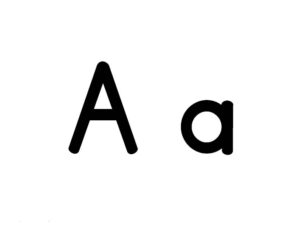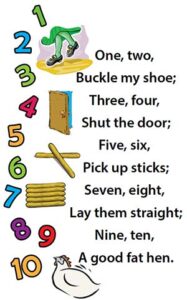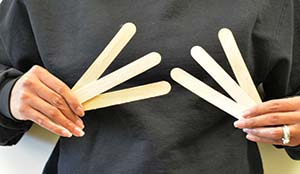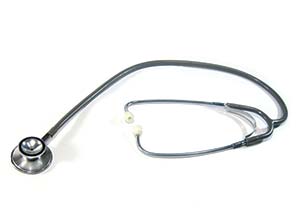Oral language, Letter knowledge
Children will interpret information presented in a book read aloud and increase the number of novel words they understand. Children will also say the sound of letter A.


New:
Review:
Be Prepared: This is the third of three repeated readings of a book with children. Today’s session focuses on children’s interpretation (explanations, reasoning) of information presented in the book. The session also will help children understand more novel words. From the list of novel words you identified prior to your first reading of the book, select 2–3 words to define for children today. See the Language/Literacy section of the ELM User Guide: 3–5 Years for additional information on how to select and define novel words.
We are going to again practice finding a letter we know by looking for it in a sentence. When we find the letter, we will also say the sound the letter makes.
[Write the following sentence on a chart or whiteboard. Read each word as you write the sentence:
We do lots of different things in our class.]
We want to find the lowercase letter a in our sentence.
 [Display letter card A. Point to the lowercase a on the card.
[Display letter card A. Point to the lowercase a on the card.
Encourage a volunteer child to look for and point to the lowercase letter a in the sentence as you display the A letter card.]
What sound does the letter A make?
Yes! Letter A says /a/. Let’s together say the sound of the letter A: /a/.
Now let’s spend some time with our book.
[See Week 3, Day 5 of Language/Literacy for a description and examples of how to approach today’s book reading. Key aspects are summarized below:
Number knowledge
Children will deepen their understanding of how to form a group of a given quantity.


Review:
 Let’s together say the counting rhyme we learned on Day 1.
Let’s together say the counting rhyme we learned on Day 1.
[Say the rhyme and then lead children in the rhyme, “One, Two, Buckle My Shoe.” Emphasize each number and hold up a finger for each number.]
On Day 1 we each had a group of circles (counters). Each of our groups had a different number of circles. We each counted the number of circles in our group.
Let’s practice counting a group of sticks. Our rhyme today talks about sticks. We can count groups of sticks, too.
 [Hold up a group of six craft sticks.]
[Hold up a group of six craft sticks.]
I have a group of craft sticks.
[Place sticky tack on the back of each of the six craft sticks and display them on a board. Ensure the board is visible to all children. Encourage children to count out loud as you point to each stick. Do not count out loud unless children need your assistance.]
This week we also played a game called “High Five.” A “High Five” is called “High Five” because we have five fingers on one hand that we put up high when we do a “High Five.” This week we used the number of dots on a card to tell us whether we had a “High One,” “High Two,” “High Three,” “High Four,” “High Five,” or maybe a “High Ten.”
Let’s look at some cards and count the number of dots on a card together. Then we can give each other a “high” sign with the number of fingers our card says.
[Display dot cards, one at a time, that offer appropriate challenge for children.
We listened to a story and made caterpillars with different numbers of pom-poms.
Who would like to show the caterpillars you made?
[Invite 2–3 children to share their pictures. Encourage each child to count the number of pom-poms in each caterpillar.]
This week we’ve had fun counting and making groups. We know how to count a group of items.
Extra support
Enrichment
Provide children with a board game to play. Many board games for preschool children help them learn how to count items. Examples of counting board games include Hi Ho Cherry-O®, Chutes and Ladders®, Sorry®, and Count Your Chickens®.
Ask “how many” throughout the day. “How many blocks are in your building?” “How many shoes are you wearing?” Encourage younger children to count smaller groups and older children to count larger groups.
Motor development
Children will understand the concept of physical exercise.


New:
Review:

Be Prepared: Identify a movement song to use for this activity. Some options include CDs by Greg and Steve: Ready…Set…Move! (songs: “Ready, Set, Move” and “Jump Down, Turn Around”), Kids in Motion (songs: “Body Rock,” “The Freeze,” or “Animal Action”), or We All Live Together, Vol. 2 (songs: “Listen and Move” and “The Boogie Walk”).
Yesterday we learned there are muscles in our bodies that make things move. We used our muscles to move parts of our body from our head to our toes. We moved our arms and legs and other things. Is our tongue a muscle? (yes) Is our heart a muscle? (yes)
Muscles are an important part of our body. We can help keep our muscles strong and healthy by exercising. Exercise means we move our body, or part of our body, for a certain number of times or certain amount of time. We can exercise our arm by moving it up and down 5, 10, or 15 times. We can exercise our legs by running for 1, 5, or 10 minutes.
[Remind children of exercise activities that may be done regularly in your classroom.]
Usually we breathe faster when we exercise. Our heart also works faster when we exercise. Remember, our heart is a muscle that pumps blood to different parts of our body.
Let’s pay attention to how we breathe faster when we exercise. We know how to concentrate on our breathing. Let’s all lie on the floor and put our hand on our stomach. We can feel our stomach move as we breathe.
[Provide a brief time for children to concentrate on their breathing.]
Now let’s run in place to some music. Running in place means we stay in our personal space. We do not run around the classroom. Let’s try to run as fast as we can without moving around the classroom. Running is a good way to exercise.
[Encourage children to run in place to music for several minutes.]
Please stop running and lie on the floor. Put your hand on your stomach so you can feel your stomach move as you breathe.
Exercise can help keep our muscles strong and healthy. Running is one way to exercise. What happened today to our bodies when we did a little running? (we breathed faster, our hearts pumped faster)
Extra support
Enrichment

Ask children whether they notice their heart beats faster when they run or play a sports game that involves a lot of physical movement.
Provide a movement CD for children to participate in exercise activities of your choice. If available, provide a stethoscope so children can hear the difference in their heartbeat before and after exercise.
Encourage children to participate in some exercises of your choice. Encourage children to feel their heartbeat and their breathing before and after exercising.
Exploring Where We Live
Social Studies
Skill and Goal
Knowledge of physical environments
Children will strengthen their understanding of differences in home characteristics.
Materials
Needed
Key
Concepts
Review:
Also
Promotes
Optional
Reading
[There are two options for today’s activity involving shoebox homes made by children in Week 11.
Option One: Discuss shapes (square, circle, triangle, rectangle) found in shoebox homes made by children. Encourage children to describe the shapes they find in their shoebox home. Invite children to draw shapes they find in their shoebox home on a piece of paper.
Option Two: Encourage children to draw a picture of their own shoebox home. Invite children to point to and describe the shapes in their drawings.]
Scaffolding Tips
Extra support
Enrichment
Center Activity
Provide the book Home by Carson Ellis. Encourage children to find things in the pictures of homes that are similar to their own homes. (table, sofa, roof, windows, etc.)
Family Child Care